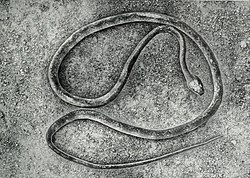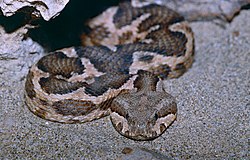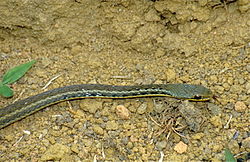The reptiles of western North America, an account of the species known to inhabit California and Oregon, Washington, Idaho, Utah, Nevada, Arizona, British Columbia, Sonora and Lower California (1922) (14582266377)
Identifier: reptilesofwester02vand (find matches)
Title: The reptiles of western North America, an account of the species known to inhabit California and Oregon, Washington, Idaho, Utah, Nevada, Arizona, British Columbia, Sonora and Lower California
Year: 1922 (1920s)
Authors: Van Denburgh, John, 1872-1924
Subjects: Reptiles Lizards Serpents Turtles
Publisher: San Francisco, California Academy of Sciences
Contributing Library: Smithsonian Libraries
Digitizing Sponsor: Smithsonian Libraries
View Book Page: Book Viewer
About This Book: Catalog Entry
View All Images: All Images From Book
Click here to view book online to see this illustration in context in a browseable online version of this book.
Text Appearing Before Image:
frontand behind. The blotches are paler centrally, where thebrown color is merely sprinkled over the white ground.Along the sides are smaller brown spots, two or three scalesin diameter, in a more or less double series, usually alternat-ing with the dorsal blotches. A broad dark line crosses thehead on the prefrontals and is continued down and backthrough the eye to a point above the angle of the mouth.There are a few irregular spots on the posterior portion ofthe frontal, the parietals, the anterior portion of the neck,and some of the supralabials. The lower surfaces are white,without markings. Length to anus 272 321 363 Length of tail 28 29 40 Distribution.—Only five specimens of this snake havebeen found. The original one was brought from the upperpart of Lower California by Mr. William M. Gabb. Mr.Belding and Mr. Slevin each secured one at La Paz nearthe southern end of the peninsula. The fourth specimen Oi . Pmm k , Cm,. A( \ii. S(-i., \<)I,. \ ( \ A V 1^1 s 1; r I! 1, 11 I
Text Appearing After Image:
30. PHYLLORHYNCHUS—il. E LAP HE 697 was collected by Mr. Herbert Brown at Yuma, Arizona.Miss Atsatt recently recorded the finding of one in thewash from Tahquitz Creek, near Palm Springs, RiversideCounty, California. Remarks.—This and the preceding may eventually befound to be one species. There is little if any differenceexcept in the keeling of the scales. Habits.—Miss Atsatt very kindly has furnished me witha photograph of the snake found at Tahquitz Creek, andthe following notes on the habits: The specimen of Phyllorhynchus decurtatus lived untilJuly. It is now in the Museum of Vertebrate Zoology ofthe University of California. During the period it was un-der observation if it was in a box of sand open to the lightit spent most of the time under the sand. When it was dugout of the loose sand and placed on top it soon reburieditself. When stimulated by light or other means the snakecould bury itself completely in two or three minutes. Sev-eral times attempts were made at digg
Note About Images
Relevante Bilder
Relevante Artikel
Liste der SchlangenartenIn dieser Liste sind alle 3971 momentan bekannten lebenden Arten der Unterordnung der Schlangen (Serpentes) aufgeführt. Grundlage für die Liste ist die Online-Datenbank Reptile Database, die Rote Liste der bedrohten Arten (IUCN) und die Artenliste am Ende des Buches Schlangen – Die interessantesten Arten der Welt von Chris Mattison. Die Unterteilungen in Familien und Unterfamilien sind oft nicht eindeutig, zum Beispiel wird die Unterfamilie der Natricinae im Buch als eigenständige Familie Natricidae angeführt, in dieser Tabelle sind sie aber wie bei der Reptile Database unter den Nattern (Colubridae) gelistet. Auch bei der Gattungszugehörigkeit der einzelnen Schlangenarten ist sich die Wissenschaft oft nicht einig, weswegen auch diese geändert werden. Der Spalte „Weiteres“ kann man entnehmen, ob von einer Art nicht viel bekannt ist, ob sie ausgestorben ist oder ob sie auch noch einen anderen wissenschaftlichen Namen hat(te) (Synonym). .. weiterlesen










































